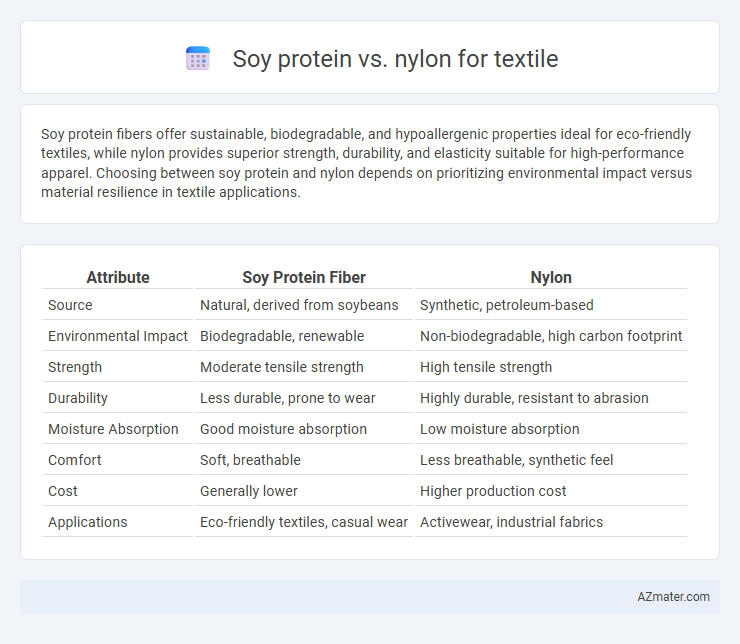Soy protein fibers offer sustainable, biodegradable, and hypoallergenic properties ideal for eco-friendly textiles, while nylon provides superior strength, durability, and elasticity suitable for high-performance apparel. Choosing between soy protein and nylon depends on prioritizing environmental impact versus material resilience in textile applications.
Table of Comparison
| Attribute | Soy Protein Fiber | Nylon |
|---|---|---|
| Source | Natural, derived from soybeans | Synthetic, petroleum-based |
| Environmental Impact | Biodegradable, renewable | Non-biodegradable, high carbon footprint |
| Strength | Moderate tensile strength | High tensile strength |
| Durability | Less durable, prone to wear | Highly durable, resistant to abrasion |
| Moisture Absorption | Good moisture absorption | Low moisture absorption |
| Comfort | Soft, breathable | Less breathable, synthetic feel |
| Cost | Generally lower | Higher production cost |
| Applications | Eco-friendly textiles, casual wear | Activewear, industrial fabrics |
Introduction to Soy Protein and Nylon in Textiles
Soy protein fibers, derived from soy flour, offer a sustainable, biodegradable alternative in textile production, known for their softness, moisture absorption, and natural luster. Nylon, a synthetic polymer made from petroleum, excels in durability, elasticity, and resistance to abrasion and chemicals, making it widely used in performance and industrial textiles. The contrasting origins and properties of soy protein and nylon significantly influence their applications and environmental impact within the textile industry.
Historical Development and Background
Soy protein fiber, introduced in the early 20th century, emerged as a sustainable alternative to traditional textiles due to its biodegradable nature and renewable source from soybean residues. Nylon, developed by DuPont in 1935, revolutionized the textile industry as the first synthetic fiber, offering exceptional strength, elasticity, and resistance to abrasion and chemicals. Both materials reflect critical advancements: soy protein in eco-friendly textile innovation and nylon in synthetic fiber technology, shaping modern fabric production and applications.
Production Processes and Raw Materials
Soy protein fibers are derived from natural soybeans through a process involving protein extraction, fiber spinning, and regeneration, emphasizing renewable agricultural raw materials and lower environmental impact. Nylon is a synthetic polymer made from petrochemical-derived monomers via complex polymerization and extrusion processes, relying heavily on non-renewable fossil fuels. The production of soy protein fibers is generally more sustainable and biodegradable, while nylon offers superior durability and elasticity but with higher energy consumption and carbon emissions.
Environmental Impact and Sustainability
Soy protein fibers offer a renewable alternative to synthetic nylon, reducing dependency on fossil fuels and lowering greenhouse gas emissions during production. Unlike nylon, which is derived from petrochemicals and contributes to microplastic pollution, soy fibers are biodegradable and compostable, minimizing long-term environmental impact. The cultivation of soybeans for fiber supports sustainable agriculture practices, enhancing soil health and reducing water usage compared to the resource-intensive production of nylon.
Mechanical Properties and Strength Comparison
Soy protein fibers exhibit moderate tensile strength and good elasticity, making them suitable for flexible textile applications, whereas nylon boasts significantly higher tensile strength and superior abrasion resistance, contributing to its durability and long-lasting performance. The elongation at break for nylon surpasses that of soy protein, ensuring greater stretchability and recovery in fabrics. Mechanical properties such as Young's modulus are higher in nylon, indicating a stiffer and more robust fiber ideal for high-stress environments compared to the comparatively softer characteristics of soy protein fibers.
Comfort, Texture, and Aesthetics
Soy protein fibers offer superior comfort due to their breathability and moisture-wicking properties compared to nylon, which tends to trap heat and moisture. The texture of soy protein textiles is naturally soft and smooth with a silk-like feel, whereas nylon has a more synthetic, slightly coarse finish. Aesthetically, soy protein fabrics provide a matte, natural look that appeals to eco-conscious consumers, contrasting with nylon's shiny, synthetic appearance often used for high-performance or fashion-forward garments.
Durability and Maintenance
Soy protein fibers exhibit moderate durability with good elasticity but tend to degrade faster under prolonged exposure to moisture compared to nylon, which offers superior tensile strength and abrasion resistance. Nylon's high durability ensures longer lifespan and resilience in demanding textile applications, while soy protein fibers require gentler handling and more careful maintenance to prevent weakening. Maintenance of soy protein textiles involves mild cleaning agents and avoidance of high heat, whereas nylon withstands frequent washing and harsh detergents, making it more suitable for heavy-duty or activewear fabrics.
Cost Efficiency and Market Trends
Soy protein fibers offer a cost-effective and eco-friendly alternative to nylon in textile production, with prices typically lower due to renewable raw materials and less energy-intensive manufacturing. Nylon maintains strong market dominance because of its durability and versatility, but rising environmental concerns and demand for sustainable textiles are driving increased interest and investment in soy protein-based fabrics. Market trends indicate a growing shift towards bio-based fibers like soy protein as manufacturers and consumers prioritize cost efficiency alongside reduced environmental impact.
Applications and End-Use Suitability
Soy protein fibers offer excellent moisture absorption and biodegradability, making them ideal for eco-friendly textile applications such as sportswear and casual clothing. Nylon provides superior strength, elasticity, and abrasion resistance, suitable for high-performance gear like activewear, hosiery, and industrial fabrics. End-use suitability favors soy protein for sustainable, comfortable wear, while nylon excels in durability and stretch-demanding environments.
Future Prospects and Innovations in Textile Fiber
Soy protein fibers show promising biodegradability and sustainability compared to traditional nylon, which relies on petrochemical resources and contributes to environmental pollution. Innovations in bio-based modifications and blending techniques enhance soy protein fiber's strength and elasticity, narrowing the performance gap with nylon. Future prospects include the development of hybrid fibers combining soy protein's eco-friendliness with nylon's durability, driving advancements in sustainable textile manufacturing.

Infographic: Soy protein vs Nylon for Textile
 azmater.com
azmater.com